
|   |

|   |
 e-mail: ukb7@rediffmail.com Moods, Movements and Melodies April 12, 2017 Contemporary dance scenario in India's Eastern metropolis, much in keeping with its Western counterparts in the current decades, has kept agog the spectators' interest. Keeping itself painstakingly away from the captivating panorama of the classical choreographic creations and the latter's diligent attention paid to Indian mythology, the contemporary dance has sought - with an ever-increasing span of attention - to discover new themes and attract non-traditional viewers to their fold. Among Kolkata's active lot, Sudarshan Chakravorty's Sapphire Creations Dance Troupe - which has now entered the Silver Jubilee year of its existence - has shown creditable initiative to mount contemporary dance in a 'Special Event' series: to present young artistes from various art disciplines with their new endeavours, while also asking established artistes, scholars, media persons and activists to showcase their work. Remarkably enough, the venues for this initiative have also opened up new non-proscenium art spaces, and encouraged more and more audiences to come and indulge in art: from cafes and bookshops to art galleries, cultural centres and corporate board rooms, indeed, with myriad choices. Sapphire Annual Gala marked recently the running of the series seamlessly for 28 quarters ever since its launch in 2010 and presented debut works by Sapphire and non-Sapphire artistes, collaborators and installations. The occasion was a happy amalgam of fun and frolics with participants ranging over a large age group that displayed a refreshing naiveté of approach, while the seniors produced a workshop-based program directed by the USA-based Mary Carbonara. Hailing from San Francisco - where she leads Mary Carbonara Dances and also co-directs Studio 200 - Mary's choreographic experience had spanned over two decades: backed by grooming at Margaret Jenkins Dance Company, Robert Moses' Kin, Liss Fain Dance and Project Bandaloop. 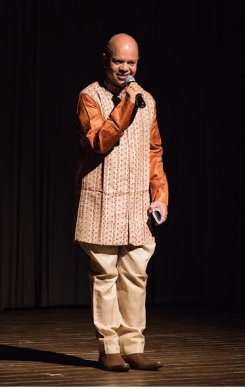 Sudarshan Chakravorty 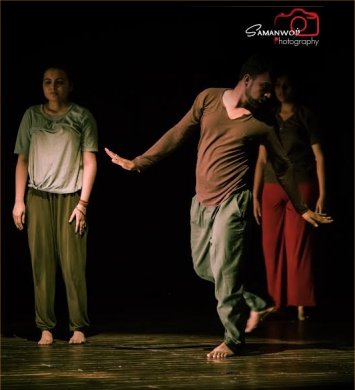 Fitting In 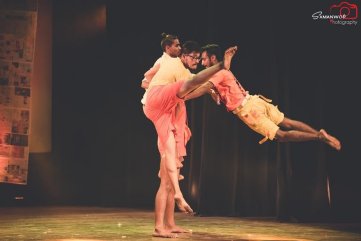
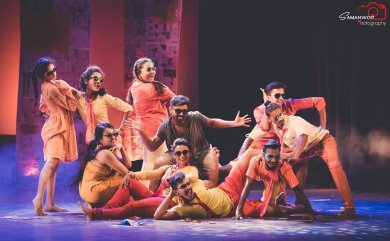
Hijibiji
The evening opened with Hijibiji, literally an abracadabra, conjuring up emotions of childhood. Our fondest memories are often those of our earliest day wonder, joy, innocence and lots and lots of games, which were enacted with enthusiasm and quicksilver change of moods. It was interesting that the item was endearingly presented by the seniors donning children's roles: a technique evolved by the Gripps Theatre in Germany and practiced effectively by Dr. Mohan Agashe in Pune in popular stage performances, but not much seen in classical dance repertoire. Fitting In followed, where the four dramatis personae seemed caught in a world full of chaos and laboured hard to find calm - and retain sanity - in their turmoil in a constant and continuous quest. There also appeared a consistent fight to lead the pack, but not enough time to finish the race! Larger than Life came next, with works by the Sapphire Playgroup and the Sapphire Academy. Delightfully backed by innovative video projections on the cyclorama, the item unfolded in four pieces. First was the Egyptian Princess, with the Cleopatra clones romping around. Second was Cinderella, the classic folklore about the unhappy maiden beset by the wicked stepmother and stepsisters, and gallantly rescued by her Prince Charming at the palace. The third and fourth pieces were Woman and Love at more abstract levels - with the belief sustained in spreading smiles, regardless of gender, religion, class and orientation - that had multiple hues oozing in the background. 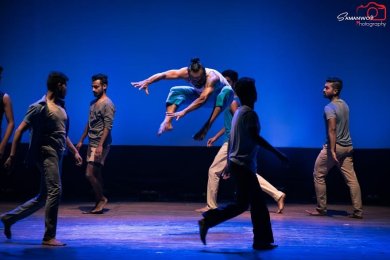
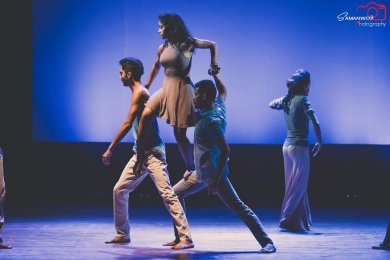
Frozen Angels
The finale, emanating from Mary's workshop, was Frozen Angels by some sixteen senior dancers. It was a painstakingly done work, revealing labyrinths and corridors of disruptions and corruptions and how we fall prey to the circumstances and yet how we come around. As was summed up by Mary, "Sometimes our best selves can be frozen inside our prejudices and fears. It can be a struggle to bring out the angels..." Extracts from interview with Mary Carbonara: 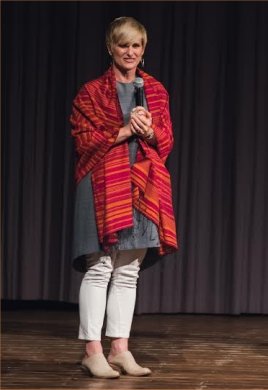 Mary Carbonara How did you evolve the structure of Frozen Angels? It was an interesting piece of choreography, where I began working with trios. I found later that duets would work better with my theme. The structure was not prefixed but it came about in successive phases. Interestingly, the main elements were completed in the first four days and a half. The rest of the 2-week workshop was spent in consolidating the elements. Did you find the prior training of your dancers of some help? Of course, I did. Incidentally, this was my second visit since I had come to work with them once earlier in 2002. I found their training was exceptionally good and their grasp of the modern dance truly amazing. My concept of movement is technically challenging, requiring a deep base of gravity, and an emphasis on shape and gesture. I am drawn to dancers who are simultaneously powerful and vulnerable. This group, as a whole, rose to the occasion. But since their skills and grasp of techniques were widely different from yours in the West, did you find that was problematic? Not at all. In fact, there was a lot of spontaneity and once I explained my theme, we began working together and things began to fall into place. My role as a dance educator is to help students dance better on their own and to deepen their knowledge - and hopefully, their love - for the art form. I only work to guide them to a greater understanding of dance, their bodies, their potential and their own creativity. What is the core of your work? As a teacher, the centre of my work is constant research into best practices and effective methods, a deep interest for the student and, of course, my love for the student. My standards are high for young and old, for beginners and professionals. My aim is that my students forever pursue their passion for dancing and that with me, they develop a healthy and efficient practice that they can access, no matter what style of dance they pursue. How do you choose your theme? My dances have always addressed social, spiritual and intellectual concerns. I've been told that my themes are often dark and difficult - loss of faith, homelessness, the culpability of witnesses to an act of violence or murder, memory and so on. Yet, it is at the circumference. It's in the centre of conflict and the loss that I am most interested: it is the place where we are most challenged to be ourselves. Whether I am dealing with the inner lives of women, the consequences of group loyalty, the impact of architecture or the mystery of faith, I work to reveal the nuances on stage. The Indian dance experience, however, is most often to look down upon the dark themes and negative emotions. What is your take? I do believe that there is, even in the darkest of situations, light at the end of the tunnel. There is always hope which we must reach. Finally, based on your assessment over two visits, do you think Indian contemporary dance is going places? I don't have the slightest of doubt!  Dr. Utpal K Banerjee is a scholar-commentator on performing arts over last four decades. He has authored 23 books on Indian art and culture, and 10 on Tagore studies. He served IGNCA as National Project Director, was a Tagore Research Scholar and is recipient of Padma Shri. Post your comments Please provide your name and email id when you use the Anonymous profile in the blog to post a comment. All appropriate comments posted with name & email id in the blog will also be featured in the site. |